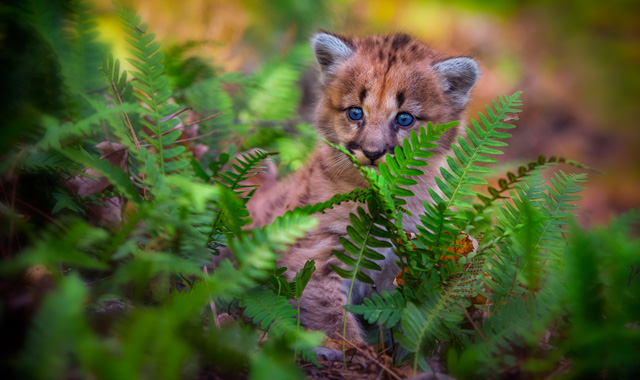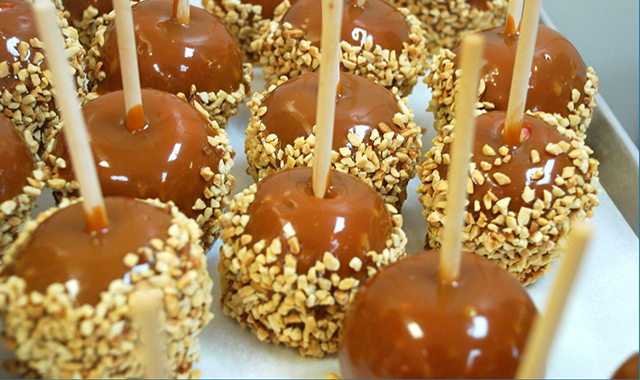Traveling through some of the wildest parts of North America, photographer David C. Olson captures elusive creatures, breathtaking landscapes and fleeting moments of natural wonder.

“Ambush,” Bobcat. This young bobcat was intensely stalking waterfowl on the shore of the Mississippi River in Illinois. I decided the best angle was to lie on my stomach, upstream from him, and let him work his way toward me.

“Eyes of the Forest,” Gray Wolf, Minnesota. Wolves are very elusive, and most sightings are over quickly. This secretive wolf peeked out of the fall foliage to view the stranger with a camera. A few images later, he disappeared like a ghost into the forest.

“Solitary Slumber,” Brown Bear, Alaska. This huge 1,500-pound bear rests his massive head on paws that sport 5-inch claws. Lying down photographing one of North America’s largest predators was a real heart-pounder. Moments like that live in your heart forever.

“Luminous Lupus,” Black Wolf, Minnesota. Subzero temperatures and the lighting immediately following sundown give this image its cold blue hues. This was a rare black phase gray wolf watching over his birch forest domain. Wolves’ eyes are designed to gather light easily so they can hunt effectively at night.

“Baby’s Got Blue Eyes,” Mountain Lion Cub. Witnessing a new cub explore the forest is really extraordinary. The eyes of this cub appear blue due to lack of pigmentation. At about 5 months of age, the cub’s eyes will turn brown.

“Thinking Of You,” Red Fox Kit, Illinois. Precious moments like this come after hours sitting in a photo blind near an active fox den. These kits are full of energy, but when it’s time to rest, a great photo opportunity can arise.

Copper Falls. Surrounded by a primeval forest, these cascading rapids, deep gorges and ancient lava flows make this a great destination for photography in Wisconsin.

“The Last Frontier,” Alaska. Fall in the Alaskan interior is splendid. The tundra has some of the best foliage color I’ve ever photographed in North America.

Bull Moose, Alaska. Fall is also mating season and a dangerous time to be photographing a 1,600-pound bull moose who’s full of testosterone, antlers and attitude. But the reward of a giant moose in fall color is well worth the risk.

Peyto Lake, Canada. One of the prettiest lakes in the world to witness. Situated in the Waputik Range Valley, it gets its color from glacial rock runoff. The color can vary depending on season and time of day. The northern end of the lake appears in the shape of a wolf head. Much native folklore exists around this mysterious lake.

“Fire on the Mountain,” Grand Tetons, Wyoming. Getting up at sunrise is well worth it for wildlife and landscape photography. On this particular morning I had to hike during the dark to get to my destination before this incredible light show at sunrise.

“Talons Down,” Red-Tailed Hawk, Illinois. Photographing birds in flight, with all feathers tack-sharp in focus, is one of the hardest things to accomplish in nature photography. This adult red-tailed hawk is coming in for a landing in all its glory.

“Ice Catch,” Bald Eagle, Iowa. This bald eagle was fishing on the frigid Mississippi River and mistakenly grabbed this ice block thinking it was a fish. Nature has always surprised me with its humor.

“Honk,” Canada Geese, Illinois. A cold, rainy spring day had the chicks under mom’s wings. Unknown to me until later, there were eight chicks under mom’s wings, and I think this one was a little excited.

“Last Light Loons.” For years, I have photographed loons in northern Wisconsin. Getting acquainted with several pairs over the years has earned me several award-winning images. This one was chosen for the Sigurd Olson Environmental Institute’s 2016 Loon Appreciation Week poster.

“Jungle Radiance,” Blue and Gold Macaw, Panama. When color, light and subject all work together in harmony, the conditions are perfect for spectacular images. This macaw was preening his feathers in the dappled light of the jungle canopy.

“Sitting Pretty,” Brown Bear, Alaska. This female bear waits for salmon to enter from the Pacific Ocean. Alaskan brown bears are the largest brown bears and require a high caloric intake. An adult bear can eat 60-80 pounds of food a day.

“Bashful Bear,” Brown Bear, Alaska. I lead photography workshops all around the country, but my clients’ favorite trip is the Alaskan bear tour. Bears, fishing, swimming, fighting – you know, just bears being bears. It’s a once-in-a-lifetime trip.

“Night Owl,” Barn Owl, Illinois. Habitat loss and pesticides have contributed to the decline of this unique, and now endangered, bird. Barn owls prefer to use farm buildings for nesting.

Timber Rattlesnake, Texas. Danger in wildlife photography comes in many sizes. This is one of North America’s most dangerous snakes, due to its long fangs and high venom yield.

About David C. Olson
Being skilled in one field of the profession is good. But very few photographers can be prolific in so many aspects of professional photography like David C. Olson, his wife Adrienne Olson, and the staff at Olson Photography in Rockford.
The Olsons’ team specializes in contemporary, high-end studio photography for businesses, schools, weddings, portraits and more. When David isn’t in the studio, he can be found in some of North America’s wildest locations, photographing elusive creatures and gorgeous landscapes. His images of our natural world have been seen worldwide in books, calendars, National Wildlife Federation and National Geographic. With more than 25 years behind the camera lens, degrees in photography from the Colorado Institute of Art, and research in animal studies, David maintains a diverse portfolio of people’s lives and memories, as well as moments in nature very rarely seen.
“Each day, I wake up knowing there are images that need to be created,” he says. “I would like my images to provoke a relaxing and healing feeling for the people who view them.”
For more on David Olson, check out DavidOlsonPhoto.com.




















































